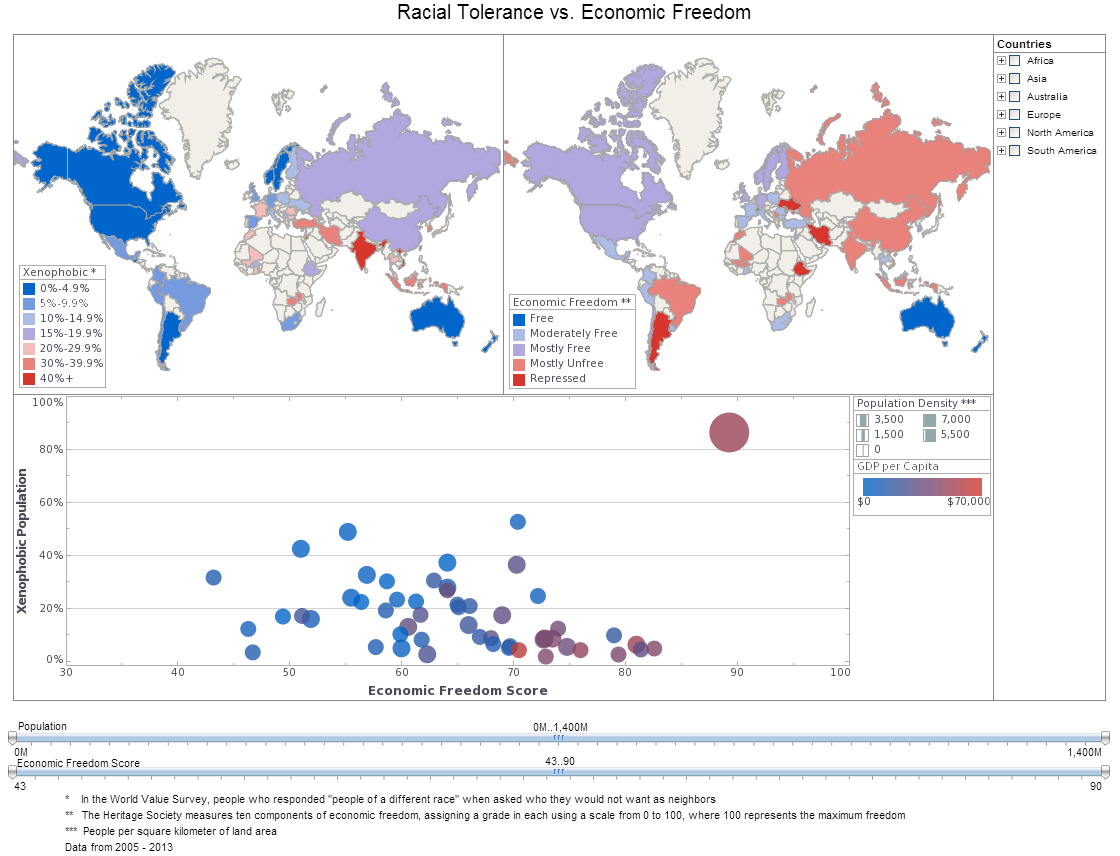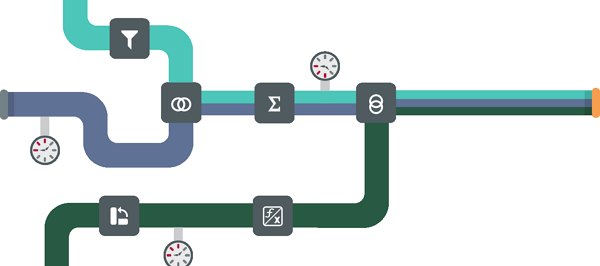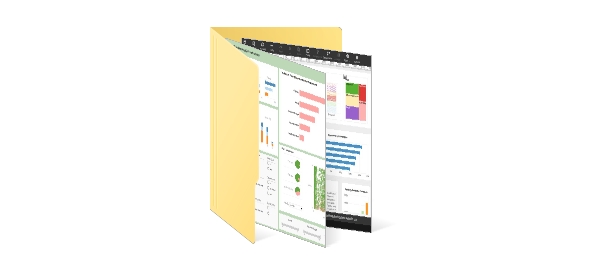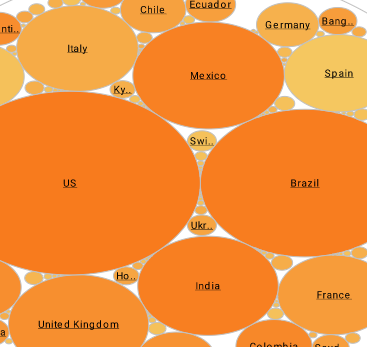Siebel Dashboard Reports
Besides being able to access almost any open standards data source, InetSoft's BI server can also access Siebel data. InetSoft provides a good option if your requirements call for:
Upgraded Dashboards and Reports for Siebel Users
No matter which Siebel application your organization uses, InetSoft offers the opportunity for a greater level of interactivity and better looking dashboards and reports compared to what is pre-built by Siebel. InetSoft is known for its leading edge data presentation and visualization software that yields quick to develop, highly engaging, user-friendly HTML5-based dashboards and reports.
StyleBI is a small-footprint Java-based business intelligence server that enables rapid development and deployment of monitoring and analytical dashboards such as this:
When you analyze the option of licensing Oracle's Hyperion BI suite, you will find these advantages from InetSoft:
- greater agility and ease of use,
- more rapid deployment times
- more flexible and affordable pricing

Developing Mashups of Your Siebel Data and Other Enterprise Data
A key strength of InetSoft's business intelligence software is its depth of support for data mashups. Data from Siebel can be combined with almost any other data source found in your enterprise including: Relational databases (JDBC), Multidimensional databases, XML, SOAP, Java beans (POJO), EJB beans, flat files, CORBA objects, OLAP cubes, SAP, PeopleSoft, and JD Edwards (JDE).
In addition, InetSoft has innovated unique capabilities for enterprise mashups. You do not have to be a BI analyst to create your own mashups. You can combine disparate tables and fields that were not previously mapped in a data model. Beyond that, you can also bring in your own data sets such as those in personal spreadsheets or those generated by vendors or partners. Whatever dashboards or reports you make from them are now shareable inside the enterprise BI space.
Supported Siebel Applications
StyleBI can access data in Siebel CRM, Enterprise Marketing Suite, and Contact Center and Service.
So whether your goal is increasing access to information among customer service representatives or creating a unified view across service operations and other functional units for managers and executives, you will be able to meet these challenges with InetSoft's dashboards and reporting software.
Why a Jade Carving and Restoration Firm Chooses StyleBI for Siebel Dashboards and Reports
For a Jade Carving and Restoration firm—an artisanal business that blends centuries-old craftsmanship with museum-grade conservation practices—customer relationships, provenance, restoration histories, and bespoke order workflows are central to the operation. Many firms in this niche run Siebel to manage customer records, consignments, loan agreements, restoration tickets, and high-value sales pipelines. Choosing StyleBI to sit on top of Siebel is a strategic move: it modernizes reporting, unlocks interactive dashboards tailored to curators and conservators, and turns siloed transaction logs into actionable business intelligence without disrupting the fragile workflows that conservators and master carvers rely on.
Siebel is strong at transaction capture and process management—tracking condition reports, treatment histories, ownership transfers, and contract milestones. But Siebel’s out-of-the-box reporting can be rigid: canned reports, limited visualization options, and constrained ways to join operational Siebel objects with external data (auction results, insurance valuations, or provenance research). StyleBI complements Siebel by providing a flexible semantic layer that maps Siebel entities—artifacts, clients, restoration jobs, conservator notes—into curated business metrics and domain-friendly dimensions. This gives curators and sales directors dashboards that tell the right story without forcing them into technical query languages.
Operationally, the firm benefits from dashboards designed for multiple, role-specific needs. Conservators need close-up timelines: prior treatments, chemical processes used, duration of stabilizing steps, and dates of sample testing. Clients and account managers need provenance trackers, insurance valuations over time, and outstanding balances tied to consignments. Workshop supervisors want load views—work-in-progress by craftsman, machine/tool availability for fine carving tasks, and estimated completion dates. StyleBI’s widget set and interactive drill paths let each role see a tailored view of the same underlying Siebel data, reducing ad hoc requests and freeing conservators to focus on delicate work rather than chasing data.
Because jade items are unique and high-value, integrating external market intelligence matters. StyleBI can fuse Siebel’s CRM data with auction house indices, market comparables, and insurance valuations to automate suggested reserve prices, expected sale windows, and risk flags for high-risk consignments. For a restoration firm selling finished pieces or advising collectors, those blended dashboards are gold: they turn raw provenance and condition data into pricing and sales strategies. Embedding these insights into the Siebel user experience via iframes or embedded components keeps workflows seamless for account teams.
Control and traceability are core concerns. Every restoration action must be auditable—what solvents were used, when did the client approve an intervention, who signed off on final cleaning. StyleBI supports governed KPIs and immutable report snapshots so that compliance artifacts and conservation documentation are available for legal review and insurance claims. The semantic layer can enforce consistent definitions (for example, what constitutes a “major intervention” vs. a “routine clean”) so that cross-departmental reports don’t fight over terminology when the board or a museum partner requests an operational summary.
Another big win is managing workshop throughput and artisan capacity. Jade carving and restoration involve long, hands-on processes that are sensitive to backlog, tooling downtime, and specialist availability. StyleBI dashboards can blend Siebel job tickets with time-and-motion logs or simple shop-floor entries to produce accurate forecasts of completion dates and capacity constraints. Forecasting the completion of large conservation projects allows sales teams to set realistic client expectations and avoids the reputational damage of late deliveries—especially critical in museum loan scenarios where installation windows are fixed.
Financial oversight improves as well. Siebel captures sales, consignments, and billing, but many firms rely on spreadsheets to reconcile restoration costs, client allowances for material, and profit splits on brokerage sales. StyleBI centralizes financial KPIs—margin by restoration type, cost-per-hour for master carving, warranty exposure for restored pieces—and ties them back to Siebel records. Finance gains timely P&L views by project and by client, which reduces month-end friction and supports smarter pricing decisions for bespoke commissions.
From an adoption and change-management perspective, the right approach is conservative and collaborative. Conservators and master carvers are not power users of analytics tools; they want clarity and speed. The implementation should begin with a small set of high-value dashboards: a restoration lifecycle view, a provenance-and-insurance ledger, and a capacity-and-ETA dashboard for workshop foremen. Pilot these with trusted users, iterate based on their feedback, then expand. Practical, scenario-based training — “how to validate a treatment history” or “how to check consignor balances before release”—drives adoption much faster than abstract classroom sessions.
Security and permissioning are non-negotiable. Styling data for internal dashboards demands fine-grained control: client-sensitive valuation data should be available only to authorized account managers; conservation protocols and research notes may need restricted access for staff privacy or intellectual property protection. StyleBI integrates with the firm’s identity management and Siebel’s access controls so row-level security enforces who sees what. This balance between openness for operational efficiency and tight control for confidentiality is especially critical when working with private collectors or museums with restrictive donor agreements.
Technical integration can be straightforward if planned well. Work with Siebel extracts or database views to populate a governed semantic layer, and decide on near-real-time vs. scheduled refresh cadence based on business need—some data (like conservation notes) is relatively static, while inventory and consignments change frequently. StyleBI’s connectors and ETL patterns allow a staged migration: start with read-only dashboards, validate numbers against Siebel reports, then expand to writable or embedded analytics where appropriate. This reduces risk and gives IT time to harden the integration.
Longer-term, the firm can extend analytics into client-facing portals and value-added services. Imagine collectors receiving a secure portal with provenance timelines, condition reports, and post-restoration monitoring photos—delivered automatically from Siebel-backed dashboards. That kind of transparency builds trust, justifies premium pricing, and turns restoration services into a differentiator. Predictive analytics also has a place: forecasting deterioration risk by environment or estimating future restoration needs based on handling patterns can create maintenance contracts and recurring revenue for the firm.




